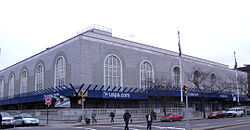Thomas Harlan Ellett

Thomas Harlan Ellett (September 2, 1880 - 1951) was an architect who practiced in New York City.
Early life and education
Thomas Harlan Ellett was born at Red Oak, Iowa in 1880, and educated at the Armour Institute of Technology in Chicago (Certificate in Architecture, 1903) and at the University of Pennsylvania's School of Architecture (B.Arch., 1906). In 1907, Ellett won the Cresson Traveling Fellowship from the Pennsylvania Academy of Fine Arts, which allowed him to travel for several years to Paris and Rome.[1]
Professional career
Following his European travels, Ellett worked for four years at the firm of McKim, Mead & White before establishing his own practice in 1915. His career was interrupted by the First World War, during which Ellett served in the United States Army Corps of Engineers.
In 1922, Ellett won an honorable mention in the Chicago Tribune Building Competition, won by his fellow New York architect Raymond Hood. In 1928, he won the Architectural League of New York's Silver Medal for his Johnson Residence in New Brunswick, New Jersey, and in 1933 he won the League's Gold Medal for the Cosmopolitan Club. In 1942, Ellett was elected to the National Academy of Design as an Associate member, and became a full Academician in 1945.
Ellett died in Garrison, New York in 1951.
Architectural works
- "Mañana," the E. Mortimer Barnes estate (1914-1920), Old Brookville, New York.
- Carol B. Alker Residence (1924), Glen Head, New York.
- "Merriewold," the J. Seward Johnson Sr. Residence (1926), New Brunswick, New Jersey.
- Cosmopolitan Club (1932), East 66th Street, New York City.
- United States Post Office–Bronx Central Annex (1937), 558 Grand Concourse, New York City.
- United States Post Office and Courthouse (1941), Covington, Kentucky, with Louis A. Simon. The building is embellished with sculpture by Carl L. Schmitz, and the interior by a sculpture of "Justice" by Romuald Kraus (1891-1954).
- Huntington, New York, Post Office.
References
- ↑ Thomas Harlan Ellett (1880-1951), A Finding Aid for Architectural Records, 1915-1948 in The Architectural Archives, University of Pennsylvania, 2002.